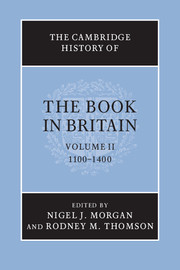2 - Language and literacy
from The roles of books
Published online by Cambridge University Press: 28 November 2008
Summary
From the Conquest to c.1200
The availability, ownership and use of books in medieval England was always conditioned by the circumstances of language, literacy and education. At the beginning of the period three languages were spoken in the country: two, Old English and Latin, had been in use for a long time, while the third, Anglo-Norman French, was a recent arrival. At the time of the Conquest the native language was Old English, represented by an impressive number of written texts which continued to be copied, along with new compositions, well into the twelfth century. The ecclesiastical culture, although Latin-based as elsewhere in Europe, had been heavily vernacularized for centuries, and was probably no less so in 1066 than it had been in the age of Bede. Old English would not be displaced as the native language, but by the second half of the twelfth century it was mutating, rapidly and violently, into what is now called Middle English. For us today, Old English is in effect another language, but speakers of Middle English, from the early thirteenth century on, seem to have been able to still read Old English, if with difficulty. Quite soon after the Conquest Latin established itself, more firmly than before, as the written language of highest status, in both books and documents. For the next two centuries most books that survive do so because they were kept in the comparative security of monastic libraries. They create an impression of a written culture almost completely dominated by Latin, and for the monasteries themselves, and for the Church as a whole, this is probably correct.
- Type
- Chapter
- Information
- The Cambridge History of the Book in Britain , pp. 22 - 38Publisher: Cambridge University PressPrint publication year: 2008



